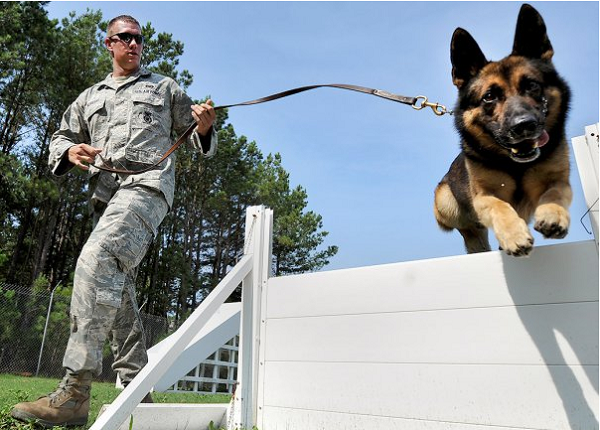Army Military Working Dog Handlers (MOS 31K) are responsible for training and caring for their service dog.
These service dogs are used in both abroad combat operations and installation security in the U.S.
Additionally, other branches of the military (including the Marine Corps), also employ dog handlers for various reasons.
They provide target odor detection and are usually seen as non-lethal threat neutralizers.
Related Article – Army Military Police (MOS 31B): Career Details
Jump To A Section
What Does an Army Military Working Dog Handler Do?
Pay and Benefits
Job Reviews
Civilian Career Opportunities
Summary
Qualifications, Training, and Duty Stations
Becoming a Military Working Dog (MWD) Handler takes an individual with patience who is willing to go through advanced training.
Not only does an individual in this position learn how to train their dog, they learn how to provide care for the dog, and they learn basic police functions.
To enter into this position, recruits will be required to achieve a 91 on the Skilled Technical (ST) ASVAB test.
You also must be able to get a Secret security clearance.
This means you must be a U.S. Citizen as in most instances, you cannot gain security clearance without being a U.S. Citizen.
Related Article – How to Join the US Military as a Non-Citizen
After completing all medical, physical, and required placement testing/clearances, recruits will attend Basic Military Training for 10 weeks.
Upon successful completion of Basic Military Training, MOS 31K Handlers will attend Advanced Individual Training (AIT) for 17 weeks.
The AIT will be broken into two phases and cover how to care for, handle, and train a Military Working Dog.
First, during phase 1, MWD Handlers will complete on-the-job instruction covering police methods and proper dog handling techniques.
This 7-week phase will cover topics such as how to arrest and restrain subjects.
Second, MWD Handlers will be taught how to incorporate a Military Working Dog into the tools they learned from Phase 1.
This 11-week phase will also consist of training your dog and providing first aid.
Helpful skills as an MOS 31K:
- Patience
- Quick decision making
- Communication and ability to interact with people
- Ability to understand training dog conditioning behavior
Duty Stations
Those serving in the Army in MOS 31K can expect to be potentially based at one of the following duty stations:
Inside the Continental US (CONUS)
- Fort Bliss, TX
- Fort Campbell, KY
- Fort Carson, CO
- Fort Cavazos, TX
- Fort Drum, NY
- Fort Eustis, VA
- Fort Gordon, GA
- Fort Gregg-Adams, VA
- Fort Huachuca, AZ
- Fort Jackson, SC
- Fort Johnson, LA
- Fort Knox, KY
- Fort Leavenworth, KS
- Fort Leonard Wood, MO
- Fort Liberty, NC
- Fort Meade, MD
- Fort Moore, GA
- Fort Novosel, AL
- Fort Riley, KS
- Fort Sill, OK
- Fort Stewart, GA
- Joint Base Lewis-McChord, WA
- Joint Base McGuire-Dix-Lakehurst, NJ
- Joint Base Myer–Henderson Hall, VA
- Joint Base San Antonio, TX
- The Presidio of Monterey, CA
Outside the Continental US (OCONUS)
- Fort Wainwright, AK
- Joint Base Elmendorf-Richardson, AK
- USAG Bavaria, Germany
- USAG Daegu, South Korea
- USAG Hawaii
- USAG Japan
- USAG Rheinland-Pfalz, Germany
- USAG Yongsan-Casey, South Korea
What Does an Army Military Working Dog Handler Do?
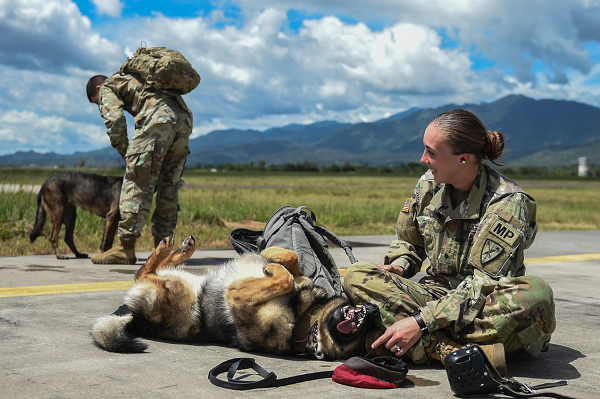
Military Working Dogs are key components in the military and police forces because of their ability to detect threats that humans cannot.
An Army MWD Handler is required to have basic law enforcement knowledge in addition to knowledge about their Military Working Dog.
MWD Handlers can work with a Patrol Drug Detector (PDDD) dog or a Patrol Explosive Detector Dog (PEDD).
Their ultimate responsibility is the training, use, and welfare of their dog.
Related Article – Army Internment Resettlement Specialist (MOS 31E): Career Details
Police Functions
They are required to know the basic use of firearms and how to arrest/restrain a suspect.
They will learn and apply both military and civil laws and jurisdictions.
MWD Handlers must know law enforcement operations to successfully and legally complete their work.
The specialist will apply Installation Force Protection and Law and Order support.
Part of their job function will be to complete Health and Welfare searches.
MOS 31K specialists will complete building searches, scouting, and detection with their dogs.
They must know security operations and be able to provide maneuver mobility support.
Related Article –Army Counterintelligence Agent (MOS 35L): Career Details
Dog Training and Care
A large part of this position is training and caring for the Military Working Dog.
The MWD must remain in good physical shape at all times, and training does not stop after the initial training.
The Handler must be knowledgeable in the principles of conditioning to ensure the physical shape of the dog.
This conditioning training will help to sustain certifications that both the Handler and the MWD must meet.
MWD Handler will learn and train the dog on basic obedience and controlled aggression.
Establishing and maintaining obedience is the groundwork for a successful partnership and is the task that Handlers will spend the majority of their time on.
Obedience training consists of simple command training to praise and situational awareness.
Learning and applying first aid treatment for the pet is also a task of the handler.
First aid treatment includes basic veterinary procedures.
These procedures can consist of dispensing medications, completing evaluations, checking the dog to ensure they are hydrated, and ensuring that the dog does not have any physical limitations.
The handler will take complete care of the dog from grooming, cleaning the kennel, and feeding to conditioning.
Communication between the Handler and the dog is very important and must be precise to avoid any mistakes or potential harm.
During training, the specialist will be required to put on the “bite suit” to learn how being on the other side of the dog’s physical prowess can be.
Learning and exploiting the Military Working Dog’s capabilities such as speed (up to 30 m.p.h.) and bite strength are both parts of training and everyday use.
Related Article – Army Animal Care Specialist (MOS 68T): Career Details
Other Job Functions
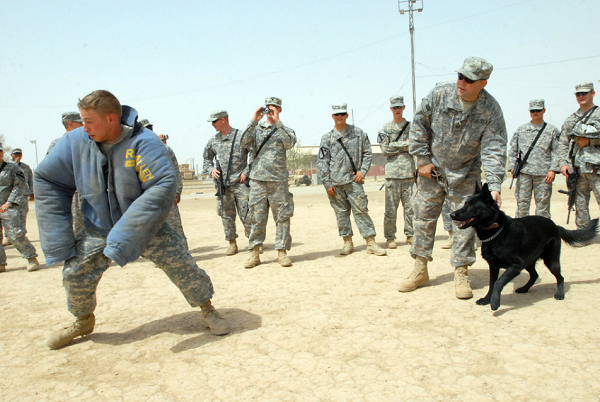
Besides searching for suspects, drugs, or explosives, the MWD may be required to assist in customs support.
They may also be required to provide protection for VIP support.
The Handlers will brief commanders on the capabilities of their dogs to detect and locate personnel, drugs and paraphernalia, weapons, ammunition, and explosive ordnance disposal.
During deployed situations, the Handler and Military Working Dog will be required to go on a route before anyone else, to look for potential threats and clear it of those threats.
This is something that is practiced during mock situations repeatedly during training and on base, to ensure accuracy for both the Handler and the MWD.
Having a Military Working Dog involved in operations expands the Military’s non-lethal capabilities.
The dogs are seen as a psychological deterrent during operations.
Some days may be the same, focusing on training yourself and your dog.
Other days may be high-stress and require you to be in a situation or scenario you have never been in before.
The Army video below discusses the job functions of a Military Working Dog Handler.
What Does a Military Working Dog Handler get Paid?
When in the Army, you will be paid based on your rank and time of service.
Entering into the MOS 31K with no prior military experience generally places individuals at a lower rank.
Like a lot of other jobs in the Army, there are many factors that play into increasing your rank and subsequently, your pay.
When recruiting there are also opportunities for bonuses based on factors such as high-demand positions and recruiting timelines.
You can follow the base pay table below to get an idea of the pay for each rank.
| Insignia | Pay Grade | Rank | Abbreviation | Minimum Monthly Pay |
|---|---|---|---|---|
| E-1 +4 months | Private | PVT | $1,917.60 | |
| E-2 | Private Second Class | PV2 | $2,149.20 | |
| E-3 | Private First Class | PFC | $2,259.90 | |
| E-4 | Specialist | SPC | $2,503.50 | |
| E-4 | Corporal | CPL | $2,503.50 | |
| E-5 | Sergeant | SGT | $2,730.30 | |
| E-6 | Staff Sergeant | SSG | $2,980.50 | |
| E-7 | Sergeant First Class | SFC | $3,445.80 | |
| E-8 | Master Sergeant | MSG | $4,957.20 | |
| E-8 | First Sergeant | 1SG | $4,957.20 | |
| E-9 | Sergeant Major | SGM | $6,055.50 | |
| E-9 | Command Sergeant Major | CSM | $6,055.50 | |
| E-9 | Sergeant Major of the Army | SMA | $6,055.50 |
Benefits
In addition to the base pay that the Army provides, they also provide benefits to their soldiers.
These benefits vary from insurance to allowances.
The Army offers free to low-cost medical and dental in addition to paid sick time and vacation.
They also cover housing and food costs.
Allowances for military clothing and civilian clothing (if needed for your position) are available annually.
Education tuition assistance opportunities could cover most or all of your continued education costs.
Related Article – Basic Allowance For Housing (BAH) Calculator
Job Reviews
Reviews of this position are positive.
People enjoy working with the dogs and creating partnerships.
The positive reviews discuss the position as being productive and allowing skills to develop such as how to handle stressful situations.
Negative reviews of the position discuss the challenges surrounding switching Military Working Dogs.
You do not always get to stay with the dog you have gained a connection with, and that can be challenging when you spend more time with that dog than with family at times.
Negative reviews also discuss long deployments and leadership having a large impact on the position.
A few Military Working Dog Handler reviews can be found below.
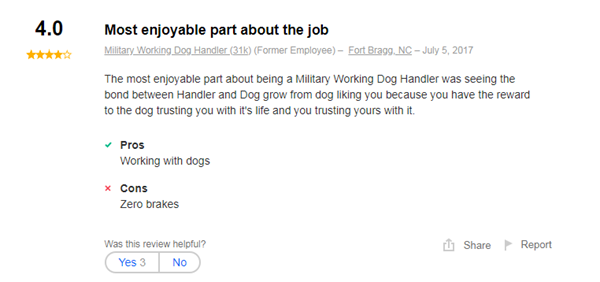
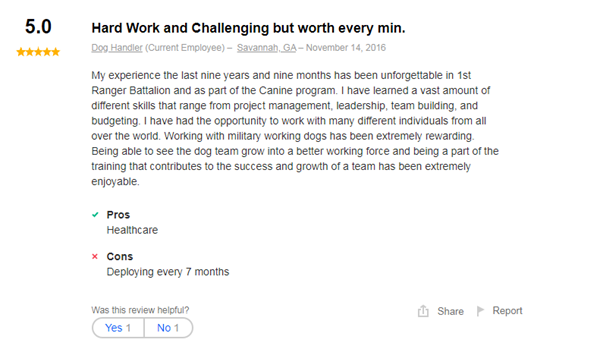
You can also view the video below from the Army.
The video gives an inside look into what training as a Military Working Dog Handler is like and what the job duties entail.
Civilian Career Opportunities
Working in the Army as a Military Working Dog Handler provides you with skills that relate to federal, state, and local law enforcement.
This can be related to working with or without a dog in law enforcement and security, as the skills learned are applicable to both positions.
Experience gained with animal care can also allow for civilian career opportunities in veterinary facilities and dog training facilities.
While in the Army, you can receive certifications (sometimes military-sponsored) that can assist with promotions and provide more civilian career opportunities.
A few certifications, that can be GI Bill funded, related to this position include Certified Protection Professional (CPP) from the ASIS International and Certified Safety Professional (CSP) from the Board of Certified Safety Professionals.
This position also qualifies for the PAYS program, a recruitment option that guarantees an interview with military-friendly employers such as the NY City Police Department and the Alabama Department of Corrections.
Quick Frequently Asked Questions
What MOS is a dog handler in the Army?
An Army Military Working Dog Handler is categorized as MOS 31K. The MOS 31 series MOS focus on law enforcement and includes military police, criminal investigations, and internment specialists.
How do I become a military dog handler?
To become a Military Working Dog Handler in the U.S. Army, you’ll need to score 91 or better on the Skilled Technical portion of the ASVAB. You’ll also need to be a U.S. citizen and obtain a Secret security clearance.
How long is training for military dog handlers?
An Army Military Working Dog Handler has 10 weeks of Basic, then 17 weeks of Advanced Individual Training. Training includes how to care for, handle, and train your dog as well as first aid and working with your dog.
Do Army dog handlers see combat?
Army Military Working Dogs are frequently trained for combat support in tracking and patrol. Working dogs will also check routes for potential threats when deployed, and some are employed for detecting explosives as well.
Do military dog handlers get to keep their dogs?
On deployment, Army dog handlers will always bunk with their dog. However, after returning home, the working dog must stay on base in the kennel. About 90 percent of military working dogs are adopted by handlers when they retire.
Summary
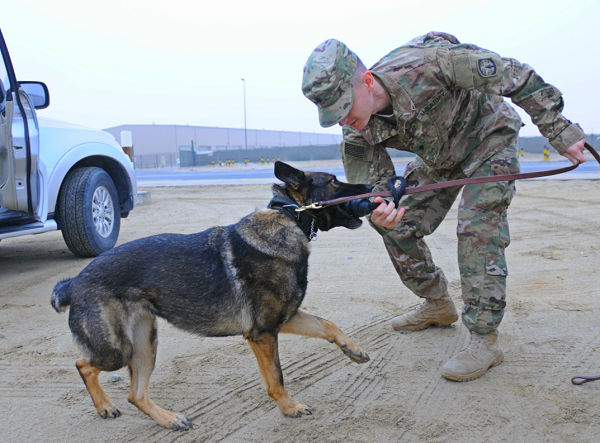
An Army Military Working Dog Handler (MOS 31K) is responsible for the care, use, and training of their Military Working Dog.
This MOS requires a security clearance and two-phase Advanced Individual Training.
The Handler will learn police techniques and proper Military Working Dog utilization.
This position is an entry-level position that follows the base pay table and offers Army benefits.
People who have previously held this position recommend the MOS to others and tend to enjoy both the job and the bonds they create with their dogs.
Working as an MWD Handler provides opportunities in law enforcement and animal training as a civilian.
Related Article: Which Branch Of The Military Should I Join? 7 Things To Consider
References:
- 68 Series MOS: A List of Medical Field Jobs in the Army - June 19, 2024
- 15 Series MOS: US Army Aviation Jobs - June 19, 2024
- 11 General Orders For Each Military Branch - June 19, 2024

